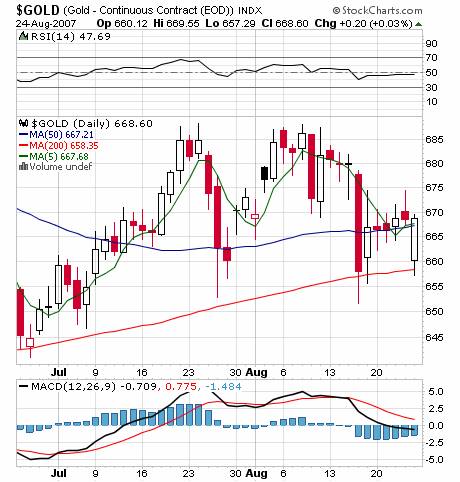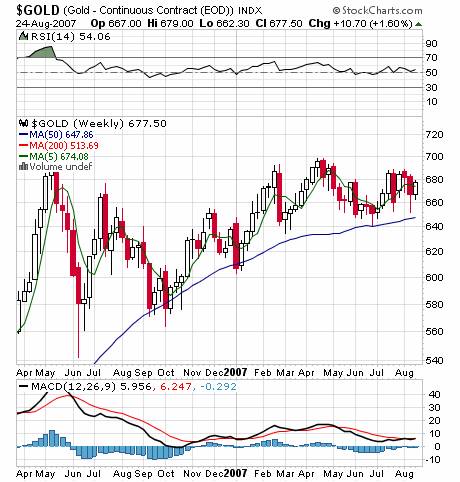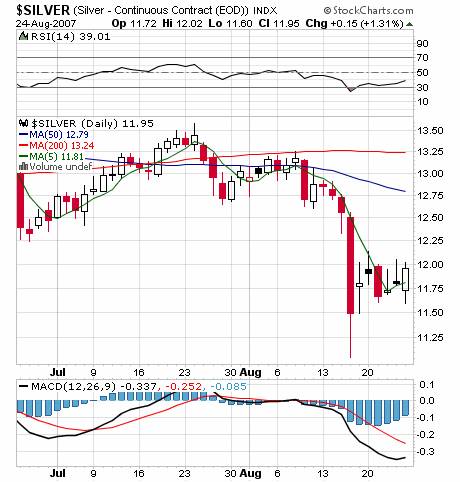Gold and Silver Analysis - Precious Points: The Question of Deflation
Commodities / Gold & Silver Aug 25, 2007 - 09:57 PM GMTBy: Joe_Nicholson
 “Gold perfectly held the 50-week moving average long watched here as strong, critical support. Resistance in the 665/70 area will be crucial to any recovery next week. Silver could now be mired in a lower trading range for the near term. At the very least, silver will likely face considerable resistance before new highs can even be contemplated. The Fed has been working behind the scenes … as it shepherds domestic growth through this decidedly difficult period. Growth... is still the outcome Bernanke seems to favor strongly.” ~ Precious Points: Gold Got Sold, but Should You Hold? , August 18, 2007
“Gold perfectly held the 50-week moving average long watched here as strong, critical support. Resistance in the 665/70 area will be crucial to any recovery next week. Silver could now be mired in a lower trading range for the near term. At the very least, silver will likely face considerable resistance before new highs can even be contemplated. The Fed has been working behind the scenes … as it shepherds domestic growth through this decidedly difficult period. Growth... is still the outcome Bernanke seems to favor strongly.” ~ Precious Points: Gold Got Sold, but Should You Hold? , August 18, 2007

Holding gold again proved to be a wise decision this week. And the area between $665 and $670 was indeed crucial, as expected. The yellow metal spent most of the week working back up through resistance in this area, where the 5- and 50-day simple moving averages had converged. The chart below shows that successfully breaking out of this level allowed gold to close above the 5-week moving average, an important support for gold rallies. The resistance between $682 and $686 still looms, however, and support in the $667/74 range will have to hold for a serious attempt at higher levels to be considered.

Silver remained within its lower trading range all week, with resistance just above $12 still keeping a lid on upward movement. Moving through $12.10 will put the next target in the area of the 50-day moving average, currently just above $12.75. Encouragingly, silver reacted well to the 5-day moving average which, though it emphasizes the lower range, at least puts a level of support between the current price and targets as low as $9.50.

Of course, as mentioned last week, the fate of the metals is inextricably linked with the ongoing crisis in the commercial paper markets and the economic growth of both the U.S.A. and the world. If we are sailing over the edge of a deflationary spiral, as some high profile pundits have asserted, then a period of minimal spending, slow to absent growth, decreasing home prices, and shrinking nominal value in general will wreak havoc on the precious metals.
The question of deflation seems to have been answered for now and, perhaps, put aside. For now. Certainly the seizure in the commercial paper market is a traditional sign of rough seas ahead for the economy, but in this instance, rather than signaling reduced capital expenditure, it merely reflects the fact that recent corporate spending has simply been financed through existing cash reserves and loans facilitated by the reduced rates at the Fed's discount window. Evidence for strong capital expenditure, and therefore a robust economic outlook, exists as strong earnings in the tech sector and Friday's strong durable goods report.
Of course, this is the situation as it is currently, and the fear is that conditions will only deteriorate from here. Housing is admittedly the albatross around the neck of the economy, but, while local conditions vary widely, median home prices on the whole have yet to exhibit a profound, deflationary collapse. This might be a function of the high-end buyer's relative strength versus the subprimer, but it is hardly the stuff of which deflationary spirals are made.
There's one other, more convincing shred of proof against a deflationary spiral, and therefore in favor of owning metals, and it's nothing less than the word of the Fed Chairman himself, albeit delivered as a Fed governor in a speech titled Deflation: Making Sure "It" Doesn't Happen Here , before the National Economists Club in November of 2002. The full text of this fascinating speech can be read online , but a single excerpt captures the thrust of the presentation:
“ I am confident that the Fed would take whatever means necessary to prevent significant deflation in the United States and, moreover, that the U.S. central bank, in cooperation with other parts of the government as needed, has sufficient policy instruments to ensure that any deflation that might occur would be both mild and brief.”
Despite the profusion of discourse on the Fed lately, and the speculation about its next moves, the legacy of Ben Bernanke's leadership should include the most transparency of any Federal Reserve Board in history. At the very least, the Fed's actions over the past three weeks have unfolded perfectly consistent with the framework presented in this newsletter for months, which was culled from the Fed's own policy and pronouncements. Curiously, the views expressed here have finally become the mainstream consensus, as the Fed's reluctance to lower the target rate is now an accepted fact and the brilliance of its unruffled chairman, widely lauded.
It follows that though a target rate cut in September does not at all appear likely now, the decision will certainly be based upon economic data, which makes next week's releases extremely important. The Fed has clearly been responsive to the recent volatility and credit crises, but it has reserved the reduction of its target rate as a tool to deal with economic weakness, rather than issues related solely to financial markets. Should the economic outlook deteriorate into anything resembling a recession or a deflationary spiral, there is no doubt the Fed will aggressively seek to remedy the situation, the eventual consequence of which will be a new leg in the precious metal bull, short term liquidations notwithstanding.
But so far, the only aspect of Bernanke's policy that was not expected was the ascetic discipline with which he's avoided creating excess liquidity to ease the financial turbulence. And to be fair, this is also a credit to his genius and his respectful knowledge of the Fed's power. Though the overnight rate has hovered well below the target, repo transactions have been modest and short term. Even the money borrowed from the discount window is being accounted for through reductions in the funds injected through open market activities. If this pattern continues, and is itself enough to weather this proto-deflationary storm, we're unlikely to see a parabolic ascent in gold anytime in the near future. Of course, since the Bernanke's policy as stated is a perpetual buffer of institutionalized inflation, even this milder setting envisions precious metals as a perpetual vehicle of intrinsic value while paper currencies are slowly, but surely devalued into irrelevance at the accepted, comfortable rate of inflation.
Finally, a third option would be a small, preemptive cut in the target rate and, existing between financial armageddon and the blasé world of anemic, but persistent growth, this would be the most desirable, bullish outcome for precious metals. It is the path described by those who believe the current reduction in the effective Fed funds rate is a stealth cut and the prelude to a reduction in the stated target. In the end, there is nothing to indicate this scenario is impossible except, of course, that it would be entirely out of character with everything displayed by the Bernanke Fed thus far. But that, apparently, is not going to stop the markets from holding on to this hope until September.
by Joe Nicholson (oroborean)
This update is provided as general information and is not an investment recommendation. TTC accepts no liability whatsoever for any losses resulting from action taken based on the contents of its charts,, commentaries, or price data. Securities and commodities markets involve inherent risk and not all positions are suitable for each individual. Check with your licensed financial advisor or broker prior to taking any action.
Joe Nicholson Archive |
© 2005-2022 http://www.MarketOracle.co.uk - The Market Oracle is a FREE Daily Financial Markets Analysis & Forecasting online publication.


